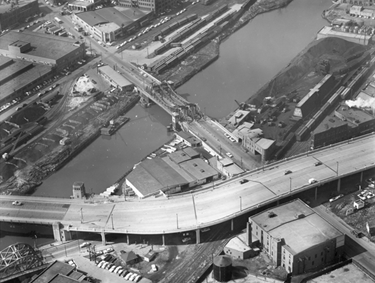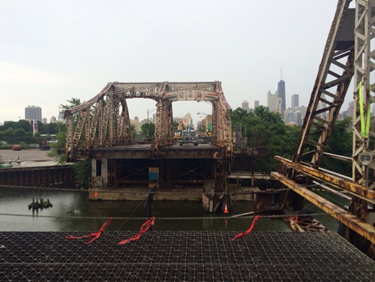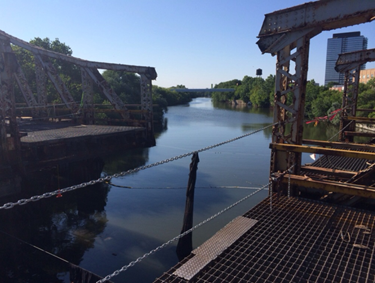
FHWA
Helps Shorten Environmental Review Process for Historic Bascule Bridge by an Unprecedented Seven Months
This spring, the East Division Street Bridge over the North Branch Canal in Chicago was spared seven months of daily repairs due to the innovative thinking and quick work of the Federal Highway Administration (FHWA), the Chicago Department of Transportation (CDOT), the Illinois Department of Transportation (IDOT), the State Historic Preservation Office (SHPO), and the United States Coast Guard (USCG). The East Division Street Bridge, one of Chicago’s 44 historic and iconic bascule-style lift bridges, was built in 1903 and, by this spring, bore serious structural problems and could support only five-ton vehicles—preventing even ambulances or fire trucks from crossing. At the same time, the bridge carried an average of 20,000 vehicles per day and provided a vital connection in the West Loop area of downtown Chicago, so the city could not risk the impacts to traffic that would result from a prolonged closure. CDOT and IDOT originally began working with USCG to secure National Environmental Policy Act (NEPA) approval. By transferring lead agency status from USCG to FHWA and expediting interagency coordination, these agencies shortened the environmental review process by seven months.
Preventing Bridge Closure through Innovative Partnerships

The East Division Street Bridge, shown here in 1956, had been in operation since its construction in 1903. (Courtesy of FWHA.)
CDOT is preparing a bascule bridge preservation plan in consultation with SHPO, IDOT, and FHWA. The plan will include considerations such as the historic context, condition, and traffic on all of the bascule bridges, and a proposal for preserving and rehabilitating these bridges, thus protecting Chicago’s icons and status as the city with the most movable bridges in the world. However, due to the deteriorated condition of the East Division Street Bridge, the agencies met and agreed to remove and replace this bridge prior to the completion of the preservation plan.
To keep the East Division Street Bridge open to traffic, CDOT began performing daily repairs in January 2014 while initiating the environmental process to build a temporary replacement structure with its own funds. The city wanted to pursue Federal funding for final construction of a new bridge on the site; however, the structure’s eligibility for the National Register of Historic Places presented a challenge. To ensure eligibility for Federal funds at the later stage, the construction of the temporary bridge had to comply with Section 106 of the National Historic Preservation Act (NHPA) and Section 4(f) of the Department of Transportation Act. FHWA, IDOT, and CDOT met in February 2014 to ensure that the replacement process would maintain eligibility for Federal funding for the final bridge replacement.
Construction of the temporary bridge did not use FHWA funds, but did require a USCG permit due to the bridge’s location over the North Branch Canal, a navigable waterway. As a result, USCG originally acted as the lead agency for obtaining approval under NEPA and completing the Section 106 and 4(f) reporting requirements. When CDOT learned that developing and approving an Environmental Assessment (EA) required by the USCG would take up to nine months, CDOT and FHWA began exploring alternatives that would shorten the timeframe and avoid the prohibitive cost of daily repairs.
The FHWA staff determined that, at USCG’s request, FHWA could take over the NEPA determination and process the project as acategorical exclusion, an action that does not significantly affect the human environment and thus does not require an EA or environmental impact statement. The USCG was able to ask FHWA to take over as the lead agency due to the Council of Environmental Quality’s Regulations for Implementing the Procedural Provisions of NEPA, which allows multiple Federal agencies involved in preparing an environmental impact statement for a project to mutually determine the lead and cooperating agencies. FHWA presented the idea to USCG, which in turn submitted a formal written request to FHWA on May 13, 2014. These decisions required great trust between the USCG, city of Chicago, and FHWA and successfully enabled the agencies to take advantage of FHWA’s legal authority to designate the project as a categorical exclusion.
Achieving Time Savings through Multi-Step, Coordinated Process
The project partners completed a multi-step process that allowed them to approve the project as a categorical exclusion and achieve the time savings to avoid a complete shutdown of the historic bridge. First, the FHWA team needed to finalize and approve the Section 106 and 4(f) documentation. Section 106 requires Federal agencies to take into account the effects of their projects on historical properties, identifying potential adverse effects and considering steps to avoid or mitigate adverse effects in consultation with the SHPO and other interested parties.
Chicago Style Bridge
The East Division Street Bridge was one of four remaining first-generation double-leaf trunnion bascule bridges, a design developed in Chicago in 1900. The two movable spans, or “leaves,” rotate vertically through the use of axles, or “trunnions,” on each river bank. This design provided more room for shipping vessels than the previous swing bridge type, in which the span rotated horizontally about a vertical support in the middle of the river. The leaves are counterbalanced with weights that lower into pits in the river bank to help the bridge open. Engineers around the world adopted the trunnion bascule design, which became known as the “Chicago style.”
For more information on the city’s movable bridges, see the Chicago Loop Bridges website.
Ultimately, FHWA, CDOT, IDOT, and SHPO ratified a Memorandum of Agreement (MOA) on May 9, 2014 that required the city and IDOT to document the historic bridge for the Historic American Engineering Record (HAER). The city hired a consultant to complete the draft HAER documentation, which was approved by the SHPO and National Park Service on May 20, 2014.
To address Section 4(f), FHWA applied the Programmatic Section 4(f) Evaluation for historic bridges. The project met the applicability criteria for utilizing this creative approach, and none of the three alternatives to demolition (do nothing, construct a new bridge in another location, or rehabilitate the bridge without affecting its historic integrity) were feasible due to the bridge’s critical condition and vital location. Once Section 106 and Section 4(f) had been addressed, CDOT proceeded with its plans to demolish and temporarily replace the structure.
Finally, IDOT evaluated the project’s impact on surrounding resources to confirm that the bridge removal and temporary replacement had minimal effects on the human environment. As it involved work in a canal rather than a stream and did not impact trees, threatened or endangered species, wetlands, homes, or businesses, impacts were limited to the historic bridge.
After completing the environmental process, executing the MOA, and completing the 4(f) and draft HAER documentation, FHWA approved the project as a categorical exclusion. After a 15-day public notice period for the USCG permit, CDOT received a permit from USCG to demolish the bridge and another two weeks later to build the temporary replacement. The bridge was closed on June 30 and the temporary structure is set to open to traffic in mid-October.
East Division Street Bridge Reconstruction Sets Example for Streamlining Environmental Review Process
The close relationships and constant communication among FHWA, SHPO, USCG, IDOT, and CDOT played a critical role in enabling the unconventional timing of the environmental review process for the East Division Street Bridge replacement project. USCG entrusted the NEPA approval to FHWA, and the agencies will continue to work with CDOT to develop a comprehensive bascule bridge preservation plan.
While the process was complex and required close coordination at multiple steps, other cities with heavily-trafficked bridges in critical condition could consider adopting the innovative process used for the East Division Street Bridge environmental review by transferring lead agency status to FHWA and processing the project as a categorical exclusion. The creative thinking and flexible partnerships used in this project shaved crucial months off the environmental review process, saving time for thousands of Chicago commuters and preserving Federal funding eligibility for the bridge’s final reconstruction.


The East Division Street Bridge was demolished and replaced during the summer of 2014. (Courtesy of FHWA)
Contact Information
Janis Piland
Environmental Engineer
Illinois Division
Federal Highway Administration
(217) 492-4989
Janis.Piland@dot.gov
Chris Byars
Transportation Engineer
Illinois Division
Federal Highway Administration
(312) 886-1606
Chris.Byars@dot.gov
Mike Hine
Illinois Division
Federal Highway Administration
(217) 492-4634
Mike.Hine@dot.gov
Look What’s New!
- FHWA, the Federal Transit Administration (FTA), and the Federal Railroad Administration issued a joint final rule amending the application requirements for the Surface Transportation Project Delivery Program. The final rule implements changes included in the Moving Ahead for Progress in the 21st Century Act (MAP-21) allowing States to apply to assume Federal NEPA authority. Click here to read the final rule.
- FHWA and FTA issued a notice of proposed rulemaking (NPRM) to implement provisions included in MAP-21 providing for additional authority for the use of planning products in the environmental review process required under NEPA. To read the NPRM click here.
- The U.S. Department of Housing and Urban Development announced a National Disaster Resilience Competition to provide $1 billion in funding to communities that have been struck by natural disasters in recent years.
Successes in Stewardship is a Federal Highway Administration newsletter highlighting current environmental
streamlining and stewardship practices from around the country. Click here to subscribe, or call 617-494-3539 for more information.

